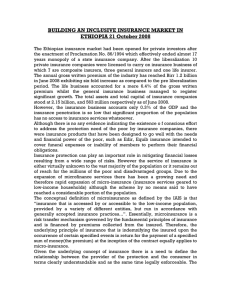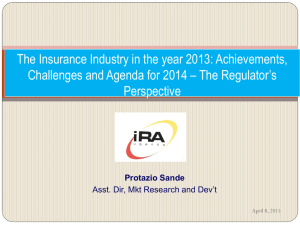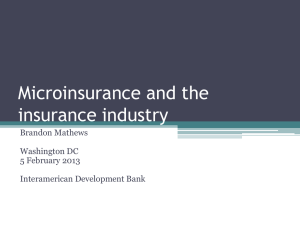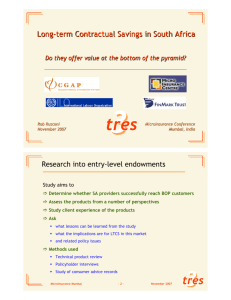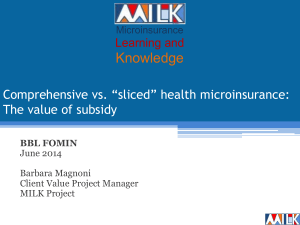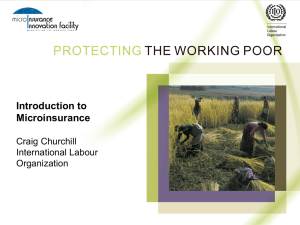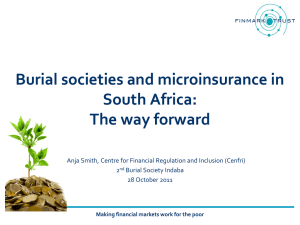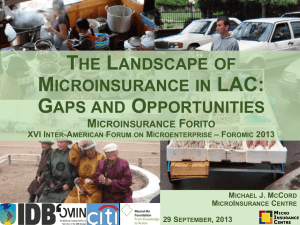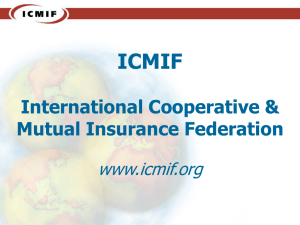Zachary Sherman December 2010 Senior thesis submitted in partial fulfillment
advertisement
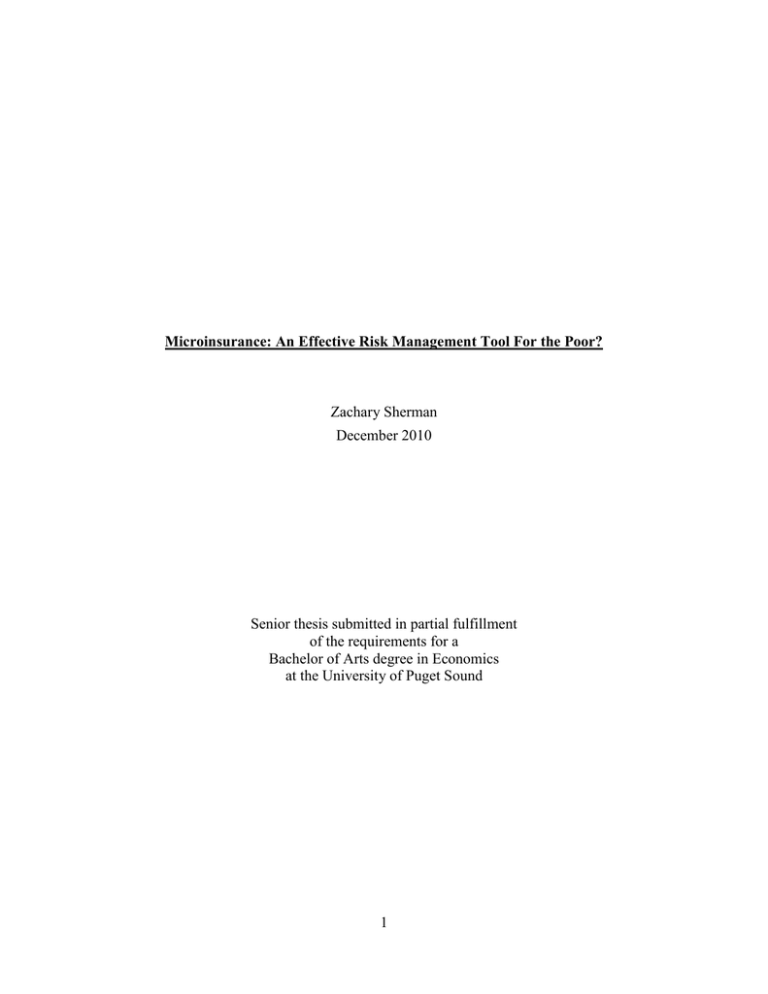
Microinsurance: An Effective Risk Management Tool For the Poor? Zachary Sherman December 2010 Senior thesis submitted in partial fulfillment of the requirements for a Bachelor of Arts degree in Economics at the University of Puget Sound 1 Introduction In recent years, there has been a dramatic increase in the role of microfinance institutions, providing services such as microlending, as a tool for economic development by NGOs and international organizations. The increase in publicity microfinance institutions are receiving has had dual impacts: first, the successes of microfinance programs have increased the demand for microcredit worldwide and second, the prevalence of microcredit programs has highlighted the need for diversification of microfinancial services. One such field that has begun to develop as a result of this demand for diversified microfinancial services is that of microinsurance. Microinsurance is a tool for increasing economic growth and development by providing small scale, low premium insurance policies to members of the poorest strata of society in the developing world. (Siegel et al, 2010) In this paper, I will be focusing on the ways in which microinsurance programs can be used as a risk management tool for the poor and the effectiveness of these programs. In order to provide risk management services, microinsurance policies are used to provide farmers and small business owners among these communities with the ability to protect their investment in capital (farm equipment, crops, storefront, etc.). The idea behind microinsurance programs is that by reducing the amount of money spent on replacing lost capital, disposable income can be increased and therefore economic growth and development is encouraged amongst the poorest communities in developing nations. Microinsurance can also provide these families with much more financial stability, removing the need to constantly maintain funds as a “safety net” against potential shocks or losses.(Morduch, 2006) Additionally, a large number of the firms which provide microfinancial and microinsurance services come from the non-profit sector. I will explore the relationship between non-profit organizations and microinsurance services, looking specifically at why non-profit 2 organizations are providing these services and how their operating methods may differ from forprofit ventures. I propose that non-profit organizations' focus on providing services and correcting market failures rather than on revenue allows them to work in fields in which profit margins are perceptibly lower. Section I – What is Microinsurance? In order to understand the effectiveness of microinsurance as a risk management tool for the poor, we must formulate a clear definition of exactly what microinsurance entails. Microinsurance can be described as “The protection of low income people against specific threats in exchange for premium payments proportionate to the likelihood and costs of the risks involved.” (Cohen and Sebstad, 2005, p.397) The important aspect of this definition is the focus microinsurance providers place on “low income people,” which make up the entirety of the microinsurance market. As such, microinsurance services need to be marketed to consumers differently than normal insurance products and need to be affordable to those living at or beneath the poverty line. Indeed, keeping insurance premiums at low enough rates to be affordable as well as profitable is one of the main goals as well as challenges faced by providers of microinsurance. (Churchill, 2006) This is no small feat, given the drastically different levels of income and vulnerability to risk faced by low income families when compared with those normally served by the insurance sector. Microinsurance can provide a number of different services within the insurance field and the programs offered by microinsurance providers vary depending on local demand and needs. The majority of microinsurance services which are available currently are life insurance programs, aimed at reducing the economic impact of death on households. The other main types of microinsurance services lie in the risk management sector, with policies ranging from housing 3 insurance to insurance on crops and other farming related products. It is this latter section, risk management tools, which I will be focusing on in this paper as it has the potential to lift a large number around the world out of poverty. Section II - Review of the Literature Given that microinsurance is still a developing new field, there was varying quality in terms of the articles available, with many of the articles I found relating to microinsurance as a mechanism for providing affordable healthcare to the poor. However, it was heartening to find that a number of development agencies such as the World Bank and the International Labor Organization had done studies of microinsurance as a risk management tool, showing that even these large organizations are taking an interest in the potential shown by microinsurance programs. (Green and Petal, 2008) To begin with, I found a number of papers that looked at the effects of natural disasters and other weather related events on those in the developing world. Many of these papers discussed the need for a mechanism by which the poor of these countries could adequately protect themselves against these threats. (Halliday, 2006; Smolka, 2006) Halliday discussed the impacts of hurricanes and mudslides on the lives of the poor in El Salvador. He describes the amount of devastation not only to houses and towns, but also to crops which the people affected depended on for survival. He also discusses the delay between the disasters and the arrival of international relief efforts. This was helpful in understanding the ways in which members of low income communities dealt with severe shocks in the absence of any assistance. The article raises the idea that having microinsurance services available in such areas prior to these events could help them recover quicker than solely depending on aid. Smolka’s paper focused more on the ways in which governments dealt with managing natural disasters, but it did provide insight into 4 this aspect in developing countries. I was also able to find a number of articles describing what microinsurance is and how it can be used to help the poor in situations where other methods of support had failed. In particular, they discussed the drawbacks to using informal methods of coping over formal ones, such as the delayed reaction between shocks and access to funds, drastic reductions in consumption as well as increased financial stress during a time of crisis. (Churchill, 2002; Churchill, 2006; Cohen et al, 2005) Another related point raised in these articles is the weakness of informal and community based coping mechanisms when under the stress of a prolonged supply shock, such as a drought. There were also a number of articles showing the positive effects of increased insurance coverage on the economy as a whole, citing increased life expectancy and disposable income as indicators of economic growth. (Arena, 2008; Hussels et al, 2005) From this we can see that increased insurance provision has numerous benefits on the recipients as well as the economy, strengthening the idea that microinsurance services would have innumerable benefits for the communities where it is available. Furthermore, microinsurance plays a role in reducing women’s vulnerability in the face of disasters and other adverse events by increasing their ability to quickly respond to and cope with these events. (Kar, 2007) Microinsurance can also provide an increased level of independence to these women, especially in the event of a spouse’s death. I was able to find a number of articles related to the different ways in which microinsurance could be provided to the public. These articles were extremely important in showing how non-profit microfinance institutions (MFIs) and for-profit insurance providers were able to work together to provide services more cheaply and efficiently. (Churchill, 2007; Chandhok, 2009) These articles were also essential in understanding exactly how microinsurance 5 services are provided and distributed, especially in rural areas. Also made clear in these articles were the numerous challenges faced by microinsurance providers, such as lack of understanding of the product, adverse selection and moral hazard. Luckily, these papers also had numerous solutions to the problems which were brought up. There were a number of World Bank Reports (Siegel et al, 2001; Skees et al, 2007) dealing with actual instances of microinsurance provision in developing countries such as India and Uganda, detailing the role of non traditional methods of microinsurance, namely, rainfall insurance. (Gine et al, 2010) These policies were described as being more effective due to the reduced impact of adverse selection, moral hazard and high transactions costs. The relative successes of the rainfall insurance program raise interesting prospects for the future, in that it could be possible to easily and accurately insure crops, which had been a very difficult task in the past. Morduch (2006) also discusses the many successes of rainfall based microinsurance over other forms, but also notes a number of flaws within the system, which will be discussed later. Section III – Why Provide Microinsurance Services? In looking at the ways in which microinsurance is provided, we must first examine the reasons why it should be provided and why these services are being demanded by poor communities in developing countries. The focus on microcredit schemes in recent years has been a positive step in the fight to provide the poor with financial services, however there are a number of social groups without access to these services or who would receive more benefits from access to other financial services. Furthermore, the potential market for microinsurance services is staggering, with an estimated 3 to 4 billion people living in poverty around the world. This is a largely untapped market and if access to microinsurance was made available to them, 6 the firms providing the services would stand to make a considerable profit. Despite the low level of marginal revenue associated with each insurance policy, the total revenue generated by this market would prove extremely profitable. (Chandhok, 2009) Providing these services is not only a way for insurance firms to make a profit, but would also ensure that gains made via other development strategies are not offset by the inability of low income households to respond adequately to shocks. To fully explore why microinsurance should be provided, we must first understand the concept of household vulnerability and the ways in which microinsurance can serve to reduce vulnerability to adverse shocks and losses. Household vulnerability can be described as a household's ability to cope with and respond to specific risks, with the ability to respond to risks depending on the household's asset base. (Siegel et al, 2010) To help understand the vulnerability faced by poor households, we can break down the impacts of adverse shocks into two stages. First is the immediate impact of the loss and the need for money to cover the losses faced by the household. Second is the longer term impact of reallocating already minimal family assets to respond to the reduction in cash flow. Without any method of lessening the impacts of losses, they can have long term effects on poor families that may not be resolved by the time another loss is experienced. (Cohen and Sebstad, 2005) The main issue that increases the level of vulnerability faced by low income households is the fact that many strategies employed by these households are ex post methods of managing risk as opposed to ex ante methods. Ex post refers to a method of managing risk after the shock or loss has taken place, while ex ante methods of risk management are undertaken before these events take place, creating a mechanism for dealing with shocks as soon as they occur. Ex post strategies take place after an event has occurred and as such does not provide benefits as quickly 7 as ex ante strategies could. Making microinsurance services accessible to poor communities can serve to shift reliance on ex post methods towards reliance on ex ante methods of protection, thereby giving these households more robust methods of mitigating the adverse impacts of shocks and losses. (Halliday, 2006) By providing families with ex ante methods of risk management, they are able to move through the different stages of responding to shocks more quickly and thus are able to reduce the financial impacts they would otherwise suffer. I will now provide a brief overview of the informal methods farmers use to support themselves during adverse shocks and the potential problems that these methods create. I will also look at drawbacks related to microfinance services and the ways in which microcredit schemes have failed in situations where microinsurance programs could prove very successful. In developing countries the poor have a number of methods of coping with losses of property or adverse shocks, many of them depending on informal family and community based relationships rather than established financial organizations and firms. Unfortunately, these informal mechanisms of coping are inferior to established financial services and can impose greater stress on families both financially and psychologically. (Churchill, 2006) During times of crisis, many poor, rural families depend on informal support networks to make it through difficult times, utilizing techniques such as borrowing money from members of their communities or asking family members to send them remittances. However, these methods of coping can often result in unanticipated problems during times of crisis. For example, when coping with an event that affects a whole region, such as a drought, community support networks often collapse as each member of the community struggles to maintain their own standard of living. These informal support networks are, for the most part, examples of ex post coping strategies and as such are susceptible to the problems associated with them. Furthermore, rural, 8 low income farmers interviewed by microinsurance facilitators expressed a desire for more formal methods of coping, citing that “they find their current options severely constrained.” (Cohen et al, 2005) Another method of coping with shocks and losses that is used by low income households is by taking out emergency loans, either from financial institutions or from other family members. Similar to utilizing informal support networks, taking out emergency loans is an example of an ex post coping mechanism and has many of the problems associated with these strategies. On top of these, however, is the added strain of having to pay off a loan, usually at a high interest rate, while struggling to deal with the losses the household has suffered. In the absence or inaccessibility of these coping mechanisms, many households follow a depressingly similar course of action. The most common response to losses by poor households is to drastically reduce consumption and stop spending money on “nonessential” items such as schooling for children, which could otherwise serve to increase their level of social capital. Reducing consumption in order to recoup losses also has the negative effect of reducing standard of living as households have a reduced ability to provide basic necessities for themselves, increased food insecurity and are less able to cope with further losses.(Morduch, 2006) Given the many problems associated with informal responses to losses, many have pointed to the rise in the availability of microcredit programs as a solution for providing risk management to the poor. However, there are a number of drawbacks to depending on microcredit programs as the solution to the woes of the poor. First is the exclusionary nature of most microcredit schemes, as they are directed mainly at the nonagricultural poor, the majority of which are business owners. (Churchill, 2002) Although this is a sound business strategy by microfinance institutions, it excludes a large amount of the rural population, which makes its 9 effectiveness as a potential risk management tool questionable. Second is the fact that a substantial portion of those receiving microcredit loans only use a portion of the loan to invest in their businesses, with the rest going towards providing the household with a “safety net” to fall back on in the event of a shock or loss. “With many MFIs charging effective interest rates of 40, 50 percent and higher, this is an expensive safety net.”(Churchill, 2006, p. 382) From this we can see that although microcredit schemes can be beneficial to those that have access to them, there is a need for a diversification of microfinancial services as microcredit loans are ill suited to the task of risk management for the poor. Section IV – The Benefits of Microinsurance Over Other Methods of Risk Management Now that I have explored the courses of action available to low income households in the absence of access to microinsurance, I will now begin to discuss the opportunities provided to poor households when microinsurance services are available to them. There are a number of benefits associated with the use of microinsurance schemes, with many of them addressing the problems related to informal coping mechanisms. First is the accessible nature of microinsurance, which is targeted at those most in need of financial services, namely low income, rural poor involved in the agricultural sector. Microinsurance also provides poor households with the means to stabilize their income in the face of losses, which serves to increase their standard of living. Additionally, the provision of microinsurance services to communities who already have access to microcredit programs serves to increase the effectiveness of each program respectively. (McKinnon, 2004) As stated above, one of the main advantages of microinsurance over microcredit is that it is targeted at the poorest communities in developing nations. As such, it is able to provide services to a much larger population than microcredit programs are, which mainly focus on urban 10 and rural business owners. By increasing the potential market that receives these services, the number of people benefiting from them will also increase, leading to a larger increase in overall social benefit provided. This is an important aspect of microinsurance, especially during periods in which there are severe supply shocks. In these situations, “price increases typically harm landless laborers and other net consumers.” (Morduch, 2006)The effects of a supply shock on a market in which people have access to microinsurance is shown below. Adverse shocks, such as droughts, result in market situations such as the one shown on the next page. Supply is greatly reduced from S to S`, resulting in a shift in the equilibrium price and quantity from P* to P` and Q* to Q`, respectively. Normally in this situation, low income families would have to reduce their consumption as there is no other recourse for them to take against significantly higher costs. With access to microinsurance however, these families would be able to respond to a supply shock with a much lower decline in their standard of living, as the loss in purchasing power that otherwise would have been experienced is negated by the payout from the microinsurance provider. S’ $ S P’ P* D Q’ Q* 11 Quantity Secondly, microinsurance schemes provide families with the means to increase their standard of living as they no longer have to devote as large a proportion of their income to managing potential risk. By setting aside less money for a “safety net” to fall back on in times of crisis, the poor can increase their savings and therefore capital accumulation will become easier. (Chandhok, 2009) By freeing up income that was going towards the “safety net,” microinsurance recipients will be more able and willing to take part in income generating activities. This shows that microinsurance not only provides financial security in the face of shocks and losses but also allows the poor to do more with their limited resources. Finally, when low income communities have access to microinsurance services, there is a reduction in the demand for emergency loans as there is now a more cost effective method for members of the community to manage risk, without having to rely on each other or costly loans. By providing microinsurance services in addition to microcredit, low income communities are able to choose from a more comprehensive range of financial services. Instead of tailoring a microcredit loan to work as both a means of raising capital for a business as well as using it as a risk management tool, members of these communities can use both services more effectively and would be at a lower risk of defaulting on their loans. In fact, “some MFIs attribute over half of their loan losses to the effects of risk events,” (Chruchill, 2006, p. 384) which reinforces the idea that delinquency rates for microcredit loans would fall if microinsurance services were also provided to these people. These services also provide recipients with a higher level of marginal benefits as an increase in income by even a small margin allows for a much greater degree of financial freedom. Section V – Obstacles Faced by Microinsurance Providers Despite the many benefits associated with providing microinsurance to the poor, there are 12 still a number of obstacles to overcome before widespread microinsurance coverage can occur. First and foremost amongst these challenges is the pervasiveness of misconceptions regarding insurance amongst poor communities and the lack of actual knowledge about what these services provide. Secondly, the price of premia charged for microinsurance services can often act as a barrier to families with lower incomes, effectively barring them from receiving insurance coverage. Finally, the normal problems associated with insurance, such as adverse selection, moral hazard and the transactions costs of investigating claims take on a greater significance in the microinsurance arena. The task of providing effective insurance coverage to the poor is made vastly more difficult by a lack of understanding of the product by the target market itself. (Churchill, 2006) One aspect of this is the widely held view among the poor that insurance is a service normally reserved for the elite, which results in apprehension about the intentions of the microinsurance provider. Building off of this idea is the fact that many low income households have a very limited amount of resources to work with and convincing them to pay for an intangible product that may or may not provide a return can be a difficult endeavor. Furthermore, there have been a number of cases in which there has been miscommunication between the microinsurance provider and the recipient of the service over what is covered by the insurance policy. This can result in a decreased level of trust of insurance providers within the local community, reducing the effectiveness of microinsurance schemes. (Siegel et al, 2001) However, this problem is not without its solutions. Due to its importance in increasing the demand for microinsurance services, educating the poor has been a top priority for many microinsurance providers. One of the most effective ways of doing this has been to engage in street theater performances demonstrating the concept of insurance and the benefits poor families can derive from it. This 13 method is quite effective as it uses a very basic framework to get its message across and does not require viewers to be literate to understand the message, which is a problem when working with pamphlets or posters. The other major obstacle towards being able to provide microinsurance coverage to the poor is the level at which the premium payments are set. If the premium is set too low, there will be an influx of people who want to take advantage of microinsurance services while the provider will be unable to recoup its costs. If the microinsurance provider wants to set a higher premium in order to account for the potential risks of insuring low income households, there would be a much lower demand for the microinsurance service due to the extremely price sensitive nature of these services. For example a World Bank project aimed at providing microinsurance in India reduced the price of their services by 10% in order to gauge the effect on demand, which ultimately increased by 7%. (Gine et al, 2010) This indicates that although many people in poor communities may have a willingness to pay for microinsurance, they may not have the ability to do so and any decrease in price will see a substantial increase in demand. (Siegel et al, 2010) The next set of obstacles is faced by all insurance providers the world over, however they are even more important when providing microinsurance due to the nature of the target market and its structure. First are the problems of moral hazard and adverse selection, which negatively affect the ability of microinsurance providers to effectively perform their role in the market. For example, by providing poor farmers with the prospect of receiving payment for their goods, regardless of whether their crops fail or not, they will be less willing to put effort into producing high quality crops. (Morduch, 2006) Similarly, adverse selection is a situation in which riskier customers take part in insurance schemes while less risky customers opt not to take part in the program, resulting in more payouts by the insurance provider. These outcomes are undesirable as 14 they result in much higher costs to the provider and could jeopardize the provision of microinsurance services to the poor. Also serving to increase costs are the transactions costs associated with investigating each claim in order to determine whether a payout should be made. In the developing world, in situations where there are a large number of microinsurance recipients, the transactions costs associated with investigating each case would be quite high. This is a problem that is still being dealt with, although there are a few methods of reducing the transactions costs which I will go into later in this paper. Although there are a number of obstacles faced by the microinsurance sector, there are also solutions to these problems and as momentum builds within the sector, more solutions will become apparent and viable. Section VI – Insuring Rainfall: A More Effective Form of Microinsurance? One microinsurance scheme that was implemented in India with help from the World Bank sought to find a way of providing microinsurance without suffering from the problems of moral hazard and adverse selection. The scheme that was created was based around the level of rainfall in a rural area over the course of the monsoon season, with payouts to farmers increasing as rainfall levels fell. This was an interesting approach to take as it insured against something the farmers had no control over. By insuring against rainfall, farmers were once again given an incentive to put their full effort into their crops as they were no longer guaranteed a payout for their produce. (Gine et al, 2010) Likewise, adverse selection was also accounted for because low risk farmers would be more likely to take out insurance policies on their crops while high risk farmers would be more hesitant about taking out policies. This is due to the likelihood of their crops failing due to farmer error rather than lack of rainfall, which would not result in a payout for them. Not only does rainfall insurance help solve some of the main problems of microinsurance 15 schemes; it also has other benefits that make this form of microinsurance provision stand out from the rest. Due to its dependence on rainfall for determining payouts, data can be collected in real time from monitoring stations and payouts can be calculated without having to investigate each household's policy individually. (Morduch, 2006, p. 348) This serves to reduce time between the shock event (lack of rainfall) and the payout to farmers, as well as the transactions costs normally associated with microinsurance schemes. However, rainfall insurance schemes are not perfect and do suffer from some problems. For example, to be able to set accurate premia firms must have access to rainfall records for the past few decades, which are nonexistent in a number of Indian provinces. This means that the organizations involved have to begin taking records, and will have to continue doing so for some time, in order to provide accurate prices for their clients, who cannot afford mistakenly elevated premia. Another potential problem is the difference between rainfall monitoring stations and the houses that are a part of the microinsurance scheme. If there is too large a distance between the monitoring station and the household there could be discrepancies between the amount of rainfall and the payout to the household, which could be detrimental to the household's standard of living. In order to address this issue, the microinsurance provider must set up Section VII – Methods of Providing Microinsurance When I first began writing this paper, I theorized that the microinsurance sector would be dominated by non-profit organizations due to the miniscule profit margins associated with each policy and the prevalence of non-profits within the microfinance market. However, in doing my research I have learned that some of the largest providers of microinsurance policies in India and Southeast Asia are in fact, large banks. At first glance this may seem odd, but when factoring in the total profits gathered from all microinsurance policies and the methods of distribution 16 discussed below, it is surprising that banks in other areas of the world do not provide these services. The two main types of microinsurance provision models are the partner-agent model and the full service insurance model. (Chandhok, 2009) The full service model describes a situation in which the provider of the insurance policy is also responsible for all other aspects of distribution of services, payments and claims assessments. However, the insurer is also able to retain all of the profits from the policies sold. The partner-agent model is slightly different in that it involves the cooperation of an insurance provider, such as a bank, as well as a microfinance 1 institution . The reason for this teamwork is that each party in the model is able to take advantage of the other's comparative advantage in order to provide their services. The bank is able to utilize the MFI's networks among poor communities to sell policies as well as to conduct claims assessments quickly and cheaply. The MFI increases its ability to provide financial services to the poor, while the risk is being undertaken by the bank. The rainfall insurance scheme described above was a partner-agent model. In the partner-agent model of microinsurance provision, the bank or insurer takes all of the risk associated with the microinsurance policies the MFI is able to sell. As a result of this, it also receives all of the profits associated with the accounts, showing how this team of non-profit and for-profit firms is able to work together effectively. By allowing the insurer to take all of the profits and only receiving enough money to cover its costs, the MFI is able to meet the nondistribution constraint, allowing it to continue working with a firm that operates for profit. A further benefit of operating in this manner is the trustworthiness that is associated with non-profit organizations. People may be more willing to trust a non-profit organization, rather than a for1 See (Siegel et al, 2001, p. 20) 17 profit organization, with their money and potential livelihoods. Section VIII – Conclusion Although microinsurance is a relatively new field that has been overshadowed by the successes of other microfinancial services, namely microcredit, it has begun to show real potential. In the absence of microinsurance services, rural, low income communities are forced to resort to informal methods of coping with losses. These losses are often ineffective or result in increased costs for the family during a time of economic hardship. Although most families manage to cope during these times, it is often at the cost of drastically reduced levels of consumption and a fall in the standard of living they enjoyed. By providing these communities with microinsurance services, they are less vulnerable to adverse shocks and property losses. They are also able to enjoy a higher level of disposable income, as they no longer need to save as much as a “safety net” against disaster. By freeing up this new income these families are able to increase their standards of living, by increasing their food and home security as well as by increasing their social capital. Also, when microinsurance schemes are used in conjunction with microcredit schemes, they are able to provide the poor with a wider range of financial services. This both increases the effectiveness of both schemes but also serves the consumer better by providing services focused on his needs. However, there are a number of problems associated with microinsurance, such as high transactions costs, moral hazard and adverse selection. These are problems that are extremely difficult to remove entirely, but some of the new methods of providing microinsurance have taken steps to reduce their impacts. In order to make microinsurance services cost effective, partner-agent models of insurance provision should be expanded as this helps to severely cut back on costs and allows for insurance services to be provided to a large number of recipients at 18 low costs due to the non-profit and for-profit actors' comparative advantages. Similarly, rainfall insurance schemes help eliminate some of the problems associated with adverse selection as well as moral hazard, making schemes in this vein a possibility for expansion in the future. Given the evidence considered in this paper, microinsurance schemes can provide a necessary service to potentially billions of needy consumers around the world. Despite the limitations I have discussed, the benefits are staggering and with more research into this field, microinsurance can become a positive force in the lives of many people living in poverty, rather than a dream that is just out of reach. 19 Bibliography Arena, Marco. "Does Insurance Market Activity Promote Economic Growth? A Cross-Country Study For Industrialized And Developingg Countries." Journal of Risk and Insurance. Vol. 75.No. 4 (2008): 921-946. Print. Chandhok, Gunita A. "Insurance – A Tool to Eradicate and a Vehicle to Economic Development." International Research Journal of Finance and Economics. Issue 24 (2009): 7176. Print. Churchill, Craig. "Trying to Understand the Demand for Microinsurance." Journal of International Development. Issue 14 (2002): 381-387. Print. Churchill, Craig. "Insuring the Low-Income Market: Challenges and Solutions for Commercial Insurers." Geneva Papers. Vol. 32. (2007): 401-412. Print. Churchill, Craig. "What is Insurance for the Poor?." Protecting the Poor: A Microinsurance Compendium. 'Ed'. Craig Churchill. Munich: International Labor Organization, 2006. Print. Cohen, Monique, Michael J. McCord, and Jennefer Sebstad. "Reducing Vulnerability: Demand For and Supply of Microinsurance In East Africa." Journal of International Development. Issue 17 (2005): 319-325. Print. Cohen, Monique, and Jennefer Sebstad. "Reducing Vulnerability: The Demand for Microinsurance." Journal of International Development Vol. 17.No. 3 (2005): 397-494. Web. 14 Nov 2010. <http://onlinelibrary.wiley.com/doi/10.1002/jid.1193/abstract>. Gine, Xavier, Lev Menand, Robert Townsend and James Vickery. “Microinsurance: A Case Study of the Indian Rainfall Index Insurance Market.” World Bank Policy Research Working Paper, No. 5459. Oct. 2010. Web. 12 Nov. 2010. <http://go.worldbank.org/DBD0XFK7I0> Green, Rebekah, and Marla Petal. "Stocktaking Report and Policy Recommendations on Risk Awareness and Education on Natural Catastrophes." OECD Journal: General Papers Vol. 21.No. 3 (2008): 217-305. Web. 14 Nov 2010. <http://www.oecd-ilibrary.org/economics/stocktakingreport-and-policy-recommendations-on-risk-awareness-and-education-on-naturalcatastrophes_gen_papers-v2008-art21-en;jsessionid=2ijljt1hp98mk.delta>. Halliday, Timothy. "Migration, Risk, and Liquidity Constraints in El Salvador." Economic Development and Cultural Change Vol. 54.No. 4 (2006): 893-925. Web. 14 Nov 2010. <http://www2.hawaii.edu/~halliday/Migration_EDCC.pdf>. Hussels, Stephanie, Damian Ward, and Ralf Zurbruegg. "Stimulating the Demand For Insurance." Risk Management and Insurance Review. Vol. 8.No. 2 (2005): 257-278. Print. Kar, Jyotirmayee. "Gender Issues in Post-Disaster Resilience Building Through Microinsurance." Icfai Journal of Risk & InsuranceThe Icfai Journal of Risk & Insurance. Vol. 20 4.No. 4 (2007): 7-19. Print. McKinnon, Roddy. "Social risk management and the World Bank: resetting the ‘standards’ for social security?." Journal of Risk Research. Vol. 7.No. 3 (2004): 297-314. Print. Morduch, Jonathan. "Microinsurance: The Next Revolution?." Understanding Poverty. 'Ed'. Banerjee, Abhijit V., Roland Benabou and Dilip Mookherjee. New York: Oxford University Press, 2006. Print. Siegel, Paul B., Jeffrey Alwang and Sudharshan Canagarajah. “Viewing Microinsurance as a Social Risk Management Instrument.” World Bank Social Protection Discussion Paper, No. 0116. Jun. 2001. Web. November 10, 2010. <http://siteresources.worldbank.org/SOCIALPROTECTION/Resources/SP-Discussionpapers/Social-Risk-Management-DP/0116.pdf>. Skees, Jerry R., Jason Hartell, and Anne G. Murphy. "Using Index-Based Risk Transfer Products To Facilitate Micro Lending in Peru And Vietnam." American Journal of Agricultural Economics Vol. 85.No. 5 (2007): 1255-1261. Web. 9 Nov 2010. <http://ajae.oxfordjournals.org/content/89/5/1255.full.pdf+html>. Smolka, Anselm. "Natural Disasters and the Challenge of Extreme Events: Risk Management from an Insurance Perspective." Philosophical Transactions: Mathematical, Physical and Engineering Sciences. Vol. 364.1845 (2006): 47-2165. Print. 21
